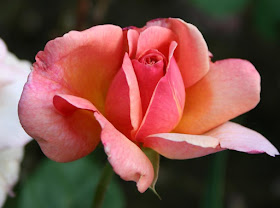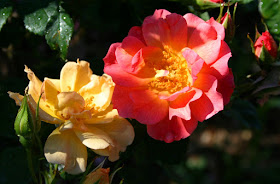 Like my friend Connie over at Hartwood Roses, ProfessorRoush has been marveling of late at the display of life represented in his garden by its more finely feathered inhabitants. After spending the early Spring fretting that my self-designed Bluebird boxes had an unusual number of vacancies, the second wave of Bluebirds has hit and every box within easy sight of my garden is occupied by a bright blue aviator. This picture, taken with my iPhone, was captured one night recently after I saw momma scoot off her nest in the box nearest my vegetable garden. I'd watched her flying back and forth from the box for about three weeks. Aren't they just a beautiful shade of blue? About half the size of the Robin eggs I photographed earlier this year, these four eggs looked for all the world like delicate china just got shipped to me in a straw-padded box.
Like my friend Connie over at Hartwood Roses, ProfessorRoush has been marveling of late at the display of life represented in his garden by its more finely feathered inhabitants. After spending the early Spring fretting that my self-designed Bluebird boxes had an unusual number of vacancies, the second wave of Bluebirds has hit and every box within easy sight of my garden is occupied by a bright blue aviator. This picture, taken with my iPhone, was captured one night recently after I saw momma scoot off her nest in the box nearest my vegetable garden. I'd watched her flying back and forth from the box for about three weeks. Aren't they just a beautiful shade of blue? About half the size of the Robin eggs I photographed earlier this year, these four eggs looked for all the world like delicate china just got shipped to me in a straw-padded box..jpg) The very next day, by a happy coincidence, I looked again and those beautiful eggs had already been replaced with these jaundiced, mostly naked and very tired chicks. Mamma Bluebird was not happy that I was back peering into the nest box. I'm going to leave these babies alone for a couple of weeks, at least until I'm able to hear them crying for food as I pass by. Sshhh...they're sleeping right now!
The very next day, by a happy coincidence, I looked again and those beautiful eggs had already been replaced with these jaundiced, mostly naked and very tired chicks. Mamma Bluebird was not happy that I was back peering into the nest box. I'm going to leave these babies alone for a couple of weeks, at least until I'm able to hear them crying for food as I pass by. Sshhh...they're sleeping right now!.jpg) The Killdeer have also been busy feigning injury in an attempt to lure my lawnmower away from a certain patch of grass in the front yard. They've undoubtedly been bragging to their friends about their success in that endeavor, because a 6 foot diameter patch of my front lawn hasn't been mowed for 3 weeks now. In the center of the grass, of course, is the usual clutch of four exquisitely camouflaged white and black speckled eggs. In actual fact, if this spot looks familiar to you, it's the exact same rocky four inch area where a Killdeer couple hatched four babies in 2011 and I blogged about here. Amazing, isn't it? An acre of mowed prairie in my front yard and these parents pick the exact same spot to raise a brood. Are they the same couple from two years ago? Are they offspring from that nest? Are there other factors about this spot that make it so attractive and so different from another rocky spot less than 2 feet away that I, a stupid human observer, would have said was nearly identical?
The Killdeer have also been busy feigning injury in an attempt to lure my lawnmower away from a certain patch of grass in the front yard. They've undoubtedly been bragging to their friends about their success in that endeavor, because a 6 foot diameter patch of my front lawn hasn't been mowed for 3 weeks now. In the center of the grass, of course, is the usual clutch of four exquisitely camouflaged white and black speckled eggs. In actual fact, if this spot looks familiar to you, it's the exact same rocky four inch area where a Killdeer couple hatched four babies in 2011 and I blogged about here. Amazing, isn't it? An acre of mowed prairie in my front yard and these parents pick the exact same spot to raise a brood. Are they the same couple from two years ago? Are they offspring from that nest? Are there other factors about this spot that make it so attractive and so different from another rocky spot less than 2 feet away that I, a stupid human observer, would have said was nearly identical? All of which leaves me wondering; Did the Killdeer just start nesting this particular spot since I built a home and started mowing the prairie for them? Or have there been decades.... centuries.... millennia of Killdeer offspring born on this same patch of earth, in the grazing grounds of ancient buffalo? I'm just shivering in delight at that thought.
.jpg) Update 6/29/13, 8:26 am: Mrs. ProfessorRoush mentioned to me last night that she had seen a "bunch" of little birds and two big ones running around the front driveway. I checked this morning, and sure enough the Killdeer eggs hatched, sometime between Thursday evening and yesterday evening. Four little balls of fluff on stilt legs running around being inefficiently herded by two anxious parents who seemed to be dividing their efforts; one to corral babies and the other to feign injury and lead me away. How can a 0.5X1.0 inch egg turn into a chick about 4 inches tall and 2 inches around almost overnight? And we humans complain about how fast our children outgrow their clothes!
Update 6/29/13, 8:26 am: Mrs. ProfessorRoush mentioned to me last night that she had seen a "bunch" of little birds and two big ones running around the front driveway. I checked this morning, and sure enough the Killdeer eggs hatched, sometime between Thursday evening and yesterday evening. Four little balls of fluff on stilt legs running around being inefficiently herded by two anxious parents who seemed to be dividing their efforts; one to corral babies and the other to feign injury and lead me away. How can a 0.5X1.0 inch egg turn into a chick about 4 inches tall and 2 inches around almost overnight? And we humans complain about how fast our children outgrow their clothes!.jpg)
.jpg)
.jpg)
.jpg)
.jpg)
.jpg)
.jpg)


.jpg)






.jpg)
.jpg)
.jpg)



.jpg)
.jpg)
.jpg)
.jpg)
.jpg)
.jpg)

.JPG)
.jpg)

.jpg)


.jpg)